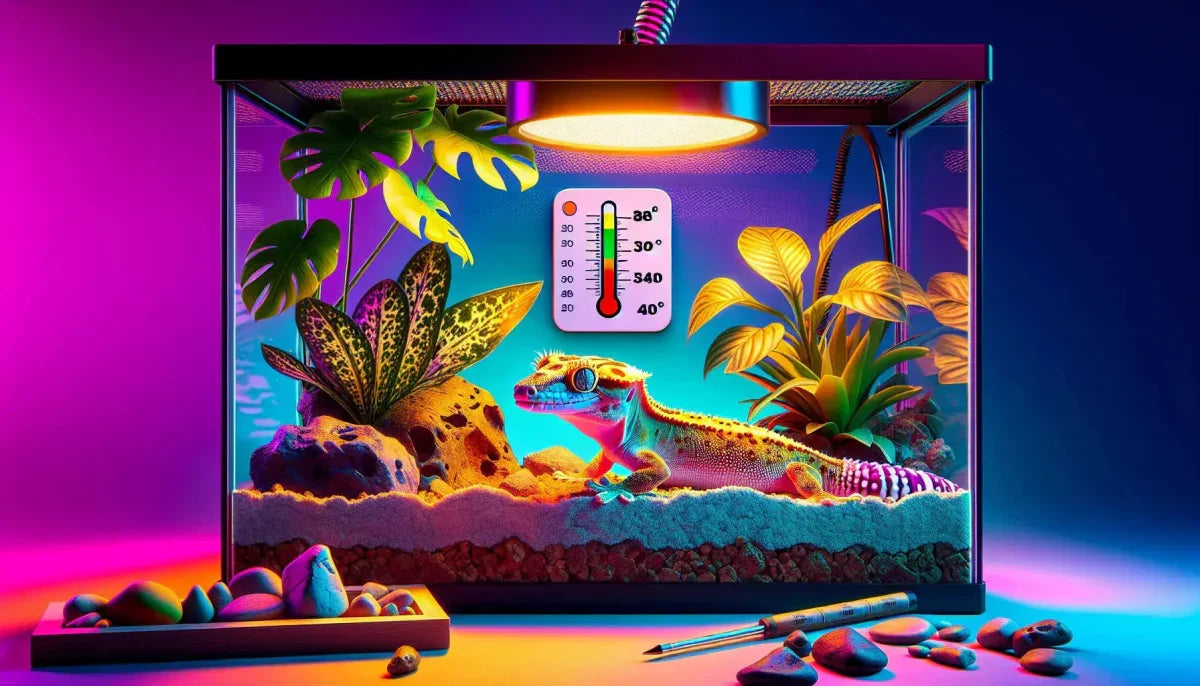Maintaining the Ideal Temperature for Crested Geckos

Maintaining the ideal temperature for crested geckos is crucial for their health and well-being. As ectothermic creatures, they rely on external sources to regulate their body temperature. In their natural habitat of New Caledonia, these geckos thrive in temperatures ranging from 72-80°F (22-27°C) during the day and slightly cooler at night. Achieving and sustaining these temperatures in captivity is essential for their metabolic functions, digestion, and overall comfort. In this guide, we will explore the various methods and tools available to ensure that your crested gecko's enclosure maintains the optimal temperature range. From heating devices and thermostats to monitoring techniques, we will cover everything you need to know to create a safe and comfortable environment for your pet. By understanding and implementing the best temperature management practices, you can help your crested gecko thrive and lead a healthy life.
Ideal Temperature Range for Crested Geckos
Crested geckos, also known as Correlophus ciliatus, are fascinating reptiles that require specific temperature conditions to thrive. Understanding the ideal temperature range for these geckos is crucial for their well-being and health.
According to various sources, including mycrestedgecko.com, swelluk.com, terrariumquest.com, and reptifiles.com, the ideal temperature range for crested geckos is between 72 to 78 degrees Fahrenheit (22 to 25.5 degrees Celsius) during the day. At night, the temperature can range between 69 and 74 degrees Fahrenheit (20.5 and 23.5 degrees Celsius). It's important to note that crested geckos can tolerate slightly lower temperatures at night, simulating the natural temperature fluctuations they would experience in the wild.
Maintaining a thermal gradient in the enclosure is essential for crested geckos. This means providing a warmer area (around 82°F or 28°C) at the top of the enclosure and a cooler area (around 72°F or 22°C) at the bottom, replicating their arboreal habitat.
It's crucial to avoid exposing crested geckos to extreme temperatures, as both high and low temperatures can lead to health issues. Consistent temperatures above 85°F (29°C) can cause stress and heat stroke, while temperatures at or below 72°F (22°C) can result in lethargy, poor appetite, and illness.
Maintaining the ideal temperature range is vital for the well-being of crested geckos. By providing a suitable thermal gradient and monitoring temperatures regularly, you can ensure a comfortable and healthy environment for these captivating reptiles.
Heating and Cooling Methods
When it comes to providing the right environment for your crested gecko, maintaining proper temperatures is crucial. Crested geckos are ectotherms, meaning they rely on external sources of warmth to regulate their metabolism and digestion. While they don't require high temperatures to thrive, it's essential to create a thermal gradient within their enclosure to allow them to adjust their body temperature as needed.
There are several methods for heating a crested gecko's terrarium. Heat lamps, such as low-wattage incandescent or halogen bulbs, are a popular choice. These lamps, when used with a metal reflector dome, provide a gentle source of heat. Additionally, heat panels and heat pads can also be used to emit infrared heat, creating a comfortable environment for your pet.
It's important to ensure that all heating equipment is connected to a compatible thermostat to maintain a safe and consistent temperature. By providing the right heating and cooling methods, you can help your crested gecko thrive in its habitat.
Crested Geckos' Temperature Requirements
Crested geckos require a specific temperature range for their well-being. It is crucial to provide a temperature gradient within their terrarium, with the warm end ranging around. 82°F (28°C) And the cool end around. 72°F (22°C) . Monitoring these temperatures is essential, and using tools like the. Etekcity Lasergrip 774 Temperature gun can provide instant readings for peace of mind.
Consistent temperatures above. 85°F (29°C) Can cause stress and heat stroke, while temperatures at or below. 72°F (22°C) Can lead to lethargy and illness. To ensure proper monitoring, it's recommended to use a probe thermometer for ambient temperature and a temperature 'gun' thermometer for surface temperature. Additionally, creating a thermal gradient can be achieved through the use of heat emitters or radiant heat panels. By maintaining the appropriate temperature range, crested gecko owners can ensure the well-being and health of their pets.
Conclusion
Maintaining the ideal temperature for crested geckos is crucial for their health and well-being. By providing the right temperature within their habitat, you can ensure that your gecko thrives in its environment. To support this, consider exploring the Zilla Micro Reptile and Amphibian Habitats Arboreal range on Talis US. This webpage offers a diverse selection of habitats, ornaments, housing accessories, and food options tailored to reptile and amphibian enthusiasts. With a wide variety of products and supplies, including terrariums, substrate, and care supplies, it caters to the specific needs of gecko owners. For all your gecko habitat needs, visit. relevant_url .






